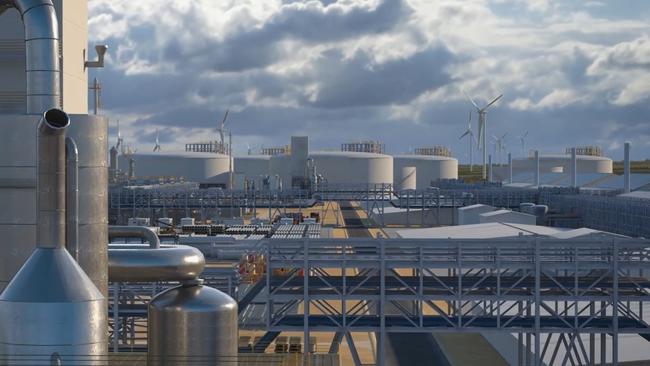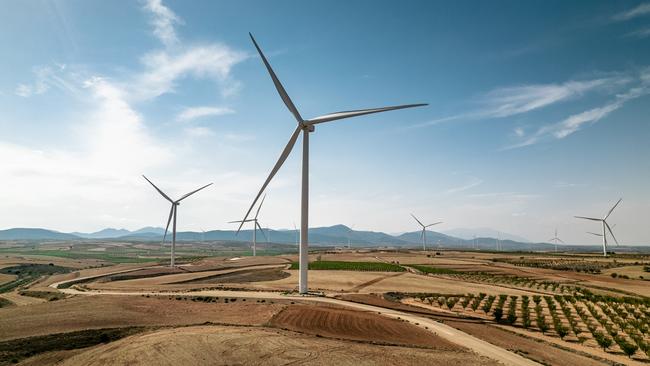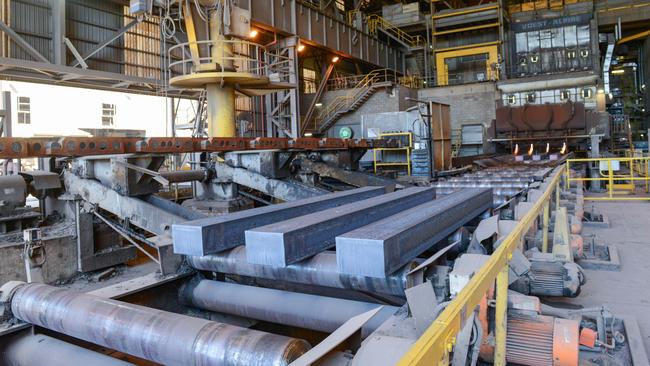Danish firm Copenhagen Infrastructure Partners unveils $30bn green energy plan in SA
A Danish renewable energy giant has unveiled a bold $30bn plan to make South Australia’s Eyre Peninsula a global wind, solar and green hydrogen powerhouse.
A Danish renewable energy giant has unveiled a bold $30bn plan to make South Australia’s Eyre Peninsula a global wind, solar and green hydrogen powerhouse.
It is part of a $100bn pipeline of Australian renewables projects being led by fund manager Copenhagen Infrastructure Partners, which is looking to capitalise on the federal government’s commitment to net zero by 2050 and its $2bn pledge to support several flagship green hydrogen projects.
The Eyre Peninsula development, dubbed “Evergreen”, would include about 4GW of solar generation capacity, 10GW of wind and 7GW of electrolysis.
That is more than double South Australia’s current network-wide generation capacity of about 6.6GW, and equates to about 1600 wind turbines, which would be erected on land somewhere between Iron Knob and Ceduna.
CIP vice-president Matthew Stuchbery said the company had spent the past 12-18 months engaging with pastoral lease holders on government-owned Crown land in the region, as well as traditional owners the Gawler Ranges and Barngarla Aboriginal corporations.
He said the region had some of the best wind and solar resources in the world, and the huge scale of the proposal would enable the company to produce hydrogen at a globally competitive price.

“For us to be able to make this economic, to be able to produce hydrogen at a price that people are going to buy it, we need to think about the generation assets first and so that’s where we look first to build the scale and drive the cost down,” Mr Stuchbery said.
“So step one is get the economies of scale and the cost of electricity down, and then you decide where the best spot is for the hydrogen production.
“Everyone is looking around Whyalla and Port Bonython and that makes sense for us too. We need to work through the engineering and figure out what makes most economic sense, but also what makes most sense for the community.
“This would be an incredibly exciting project anywhere in the world, and we’re pleased we’re able to bring this world-leading investment to South Australia.”
Mr Stuchbery said CIP was currently progressing discussions with potential offtake partners for green hydrogen and ammonia, as well as for the excess electricity generated by the wind and solar farms that could be fed back into the grid.
“We expect that some of it (electricity) will also be available for both the grid but also for direct offtake by large industrial users,” he said. “Obviously, you’ve got magnetite mining in the Middleback Ranges, you’ve got industrial processes in Whyalla and Port Augusta.
“I think one of the points of policy that has really resonated within CIP is the concept of green re-industrialisation. It’s something that is close to what has happened in Denmark.”

The project is expected to create about 1500 jobs during construction and up to 500 ongoing jobs once operational.
Further consultation and engineering work is expected over the next couple of years before CIP applies for the relevant approvals ahead of an expected final investment decision in 2028.
South Australian Premier Peter Malinauskas met with CIP representatives at last week’s World Hydrogen Summit in The Netherlands to discuss the company’s plans on the peninsula.
He used a speech at the event to spruik new legislation proposed to streamline the regulatory process for large-scale hydrogen and renewable energy projects in the state, as it positions itself as a first mover in the fledgling industry.
As part of its hydrogen push, the South Australian government is currently evaluating proposals from developers to partner in its own $593m green hydrogen plant in Whyalla, which has been flagged as a potential beneficiary of the federal government’s $2bn Hydrogen Headstart program.
The funding, announced in last week’s budget, will be used to underwrite several flagship green hydrogen projects.
Mr Malinauskas said investors from across the world were increasingly interested in the state’s “world-leading” hydrogen plans.
“We have the world’s best resource of coincident wind and solar energy, and our world-first Hydrogen and Renewable Energy Act will provide a framework to ensure we slash red tape and streamline processes for developments,” he said.

Mr Stuchbery said he was encouraged by the level of state and federal support for the nascent industry, which was important in attracting investment from major global players like CIP.
“Particularly for South Australia it’s really the combination of the resource but also the policy position of the current government,” he said.
“And like they have with the Hornsdale battery, taking a leadership position and really leaning in to try and drive the industry – that’s something that we can absolutely work with, and that has driven the enthusiasm from CIP to focus on South Australia.
“It’s the topic on everyone’s lips – the Inflation Reduction Act in the US and how other countries are going to respond to what is, in effect, a market distortion.
“And so putting that money ($2bn) on the table, with a commitment to look over the next 12 or so months at what other actions can be taken to manage some of those things that are happening internationally, is incredibly welcomed.
“One thing that we do think is important is that any of those successful projects do have an interface with domestic offtake as well. We are looking at developing partnerships, whether that’s steel makers, cement, glass to make sure that there is an element of domestic offtake for any of those early investments.”
CIP is currently progressing a pipeline of more than 30GW of clean energy investment in Australia, representing a capital value of about $100bn.
They include the Star of the South offshore wind development off the Gippsland coast in Victoria, the Murchison Hydrogen Renewables project in Kalbarri, Western Australia, and 3GW of onshore wind projects in NSW and Queensland.
It is also partnering with Queensland government-owned CS Energy on the Capricornia renewable energy hub, where pumped hydro development is the initial priority.
CIP partner and co-head of the company’s Energy Transition Fund (ETF) Karsten Plauborg said CIP had a strong track record in offshore wind projects globally, and it was now looking to replicate that success with renewable hydrogen.
“In this context we’re excited to be focussing on South Australia as the potential location of our largest ETF investment globally – working in partnership with traditional owners and a motivated community.”







To join the conversation, please log in. Don't have an account? Register
Join the conversation, you are commenting as Logout